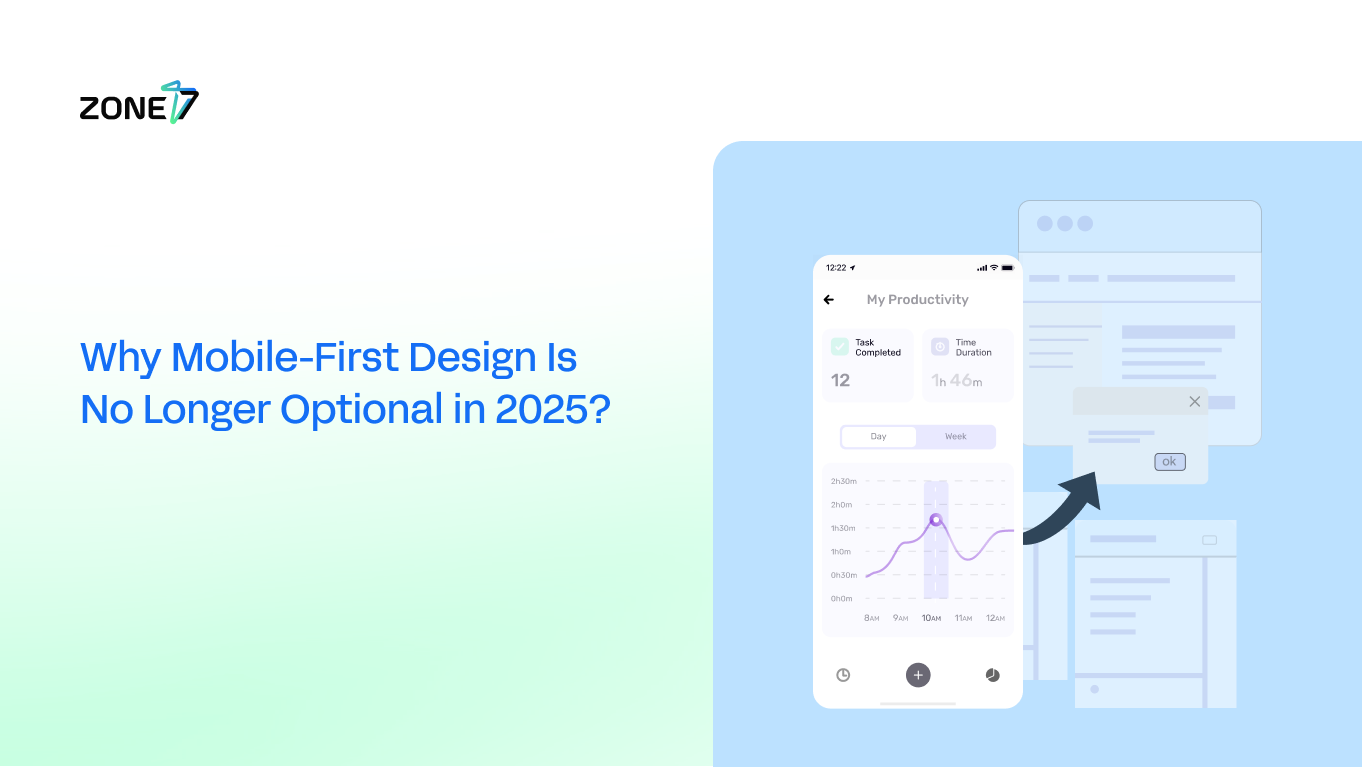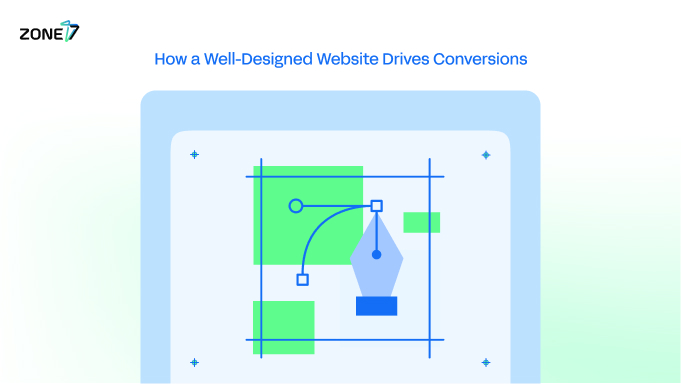The digital landscape has undergone a drastic transformation, with mobile devices now serving as the primary platform to the internet for billions worldwide. This shift is more than a fleeting trend; it represents a fundamental change in how individuals connect, consume information, conduct business, economic shifts, internet cost, etc.
These days, adopting a mobile-first design approach is not just recommended—it’s now essential.
In this comprehensive blog we delve into the evolution, significance, and best practices of mobile-first design, underscoring its pivotal role in user experience, SEO, business success, etc.
Understanding Mobile-First Design
Mobile-first design is a strategy that puts importance in designing for mobile devices before scaling up to larger screens like tablets and desktops. This approach ensures that the core functionalities and content are optimized for mobile screens, leading to a more streamlined and efficient user experience.
Historical Context
As mobile device usage began to surpass desktop browsing in day to day metrics. Industry experts recognized the need to cater to the growing mobile audience, leading to the mobile-first methodology.
The concept first gained prominence around 2009-2010.
According to Luke Wroblewski, widely credited with popularizing the term and the philosophy. He advocated for designing first for the constraints and context of mobile, and then progressively improve experience on larger screens. In his 2011 book, “Mobile First,” goes in-depth on this subject.
Popular search platform Google also played an important role. In 2010, Eric Schmidt, then Google CEO, publicly put the importance of a “mobile-first” at the forefront.
Later, Google’s move towards “mobile-first indexing” further solidified this approach.

The Rise of Mobile Usage: Data Speaks Volumes
Mobile usage has outgrown desktop as the dominant channel for internet access and traffic. As of mid-2024, over 5.64 billion people—nearly 69% of the global population—were online, with 96% accessing the web via mobile devices. Smartphones alone account for 93.7% of that access.
By late 2024, mobile phones generated over 60% of all web traffic, a trend projected to rise to 60.9% in 2025. Despite some fluctuations, mobile traffic has seen consistent growth since 2017, establishing as the primary channel.
Mobile commerce is also a booming channel for growth. In 2024, mobile devices accounted for nearly 73% of all e-commerce transactions. By 2025, the number is expected to be around 75%, with commerce projected to hit $6.5 trillion worldwide.
Worldwide Mobile Internet Usage & Traffic (2024–2025 Projections)
| Metric | Value (Year) |
| Total Internet Users (Global) | 5.64 billion (May 2025) |
| Percentage of Global Population Using Internet | 68.7% (May 2025) |
| Share of Internet Users Accessing via Mobile Phone (any) | 95.9% (Q1 2024) |
| Share of Internet Users Accessing via Smartphone | 93.7% (Q1 2024) |
| Global Web Traffic from Mobile Phones | 60.4% (Oct 2024) |
| Projected Global Web Traffic from Mobile Devices | 60.9% (2025) |
| Projected M-commerce Sales | $6.5 trillion (2025) |
| Projected M-commerce Share of Total E-commerce Sales | 75% (End of 2025) |
Source Cited:
https://www.demandsage.com/internet-user-statistics/
https://keywordseverywhere.com/blog/mobile-internet-traffic-stats/
https://cropink.com/mobile-commerce-statistics
https://www.go-globe.com/mobile-vs-desktop-usage-trends-across-the-globe
The Strategic Importance: Why Mobile-First is a Must-Have
Adopting a responsive design strategy offers strategic advantages that are critical for success in today’s mobile-dominated net.
Mobile User Experience (UX):
Mobile-first design creates a better user experience by encouraging simplicity, clarity, and ease of use. Designing within the limits of smaller screens means focusing on only the most essential features—benefiting users on all devices.
It also promotes good design practices from the start, like clear fonts, organized layouts, and smart use of space. Plus, mobile-first naturally supports accessibility with touch-friendly buttons, high contrast, and simplified interfaces, making sites easier to use for everyone, including people with disabilities.
Better Web Performance:
Speed is crucial on mobile, where users often face slower connections and have little patience for delays. Mobile-first design focuses on simplicity and efficiency, which naturally leads to faster load times.
By reducing file sizes and optimizing performance, mobile-first design keeps users engaged. Fast sites also rank better in search results, as Google favors pages that load quickly and meet Core Web Vitals like loading speed, responsiveness, and visual stability.
Potential for Search Engine Algorithms:
Google’s mobile-first ranking means it primarily uses the mobile version of a website to determine how it ranks in SERPs. So if your site isn’t optimized yet, your entire site’s visibility can suffer.
A mobile-first design naturally supports modern SEO by ensuring that content loads quickly, is easy to navigate, and displays correctly on all devices. Mobile-friendly sites are more likely to appear in top search results, earn featured snippets, and attract more organic traffic.
On the other hand, sites that aren’t mobile-optimized risk lower rankings, higher bounce rates, and lost traffic—especially as mobile searches continue to dominate.
Future-Proofing Digital Assets:
Designing with mobile-first means starting with the smallest screens and most limited environments, which naturally leads to a flexible and future-ready foundation.
This approach makes it easier to adapt to new devices, screen sizes, and technologies—like foldable phones, wearables, and whatever comes next.
As mobile traffic keeps growing and tech keeps evolving, a mobile-first design ensures your site stays modern, responsive, and relevant.
It’s a smart, long-term strategy for building a resilient digital presence.
Driving Conversions:
Seamless mobile experience directly impacts user engagement, lowers bounce rates, and improved conversion, particularly for e-commerce sites.
Mobile users are more inclined to take immediate actions, such as making a purchase or filling out a form, when presented with a streamlined and intuitive interface.
Mobile site design facilitates this by simplifying forms, reducing the number of required fields, and ensuring clear, easily tappable call-to-actions (CTAs).
This reduction of friction in the user journey directly contributes to improved business outcomes.
Competitive Edge:
While mobile use continues to dominate, many businesses still lag behind in fully adopting mobile-first strategies. Those that embrace it get a clear competitive edge.
A well-optimized mobile site not only attracts and retains users but also signals a modern, customer-first brand. Companies that prioritize mobile often capture more market share by delivering the experience today’s users expect.
The real power of mobile-first design lies in how its benefits work together. Fast-loading pages create better user experiences. Happier users stay longer, engage more, and bounce less—all of which boost SEO rankings.
Google rewards these signals through mobile-first indexing, so improving speed or usability doesn’t just help one area—it lifts everything. This creates a virtuous cycle where performance, experience, and visibility reinforce one another.
Interestingly, mobile-first constraints—like limited screen space—also drive better design. They force teams to focus on what truly matters, cutting clutter and sharpening clarity.
This results in cleaner, more efficient experiences on all devices. Instead of retrofitting a complex desktop site to fit smaller screens, mobile-first flips the script: it starts with the core value, then enhances it for larger screens. This leads to faster, leaner, and more user-centered digital products.
The Cost of Ignoring Mobile Friendly Website Design
Neglecting a mobile-first design strategy carries significant and compounding negative consequences, creating a downward spiral for a business’s digital presence.
Poor User Experience:
A site that’s with mobile-friendly layout can frustrate users right away, causing them to bounce early.
In fact, 61% of visitors will even choose to not return after a bad mobile experience, and 40% will switch to a competitor instead.
A study showed mobile users are five times more likely to abandon a task if they encounter poor experience.
Search Engine Algorithms Penalties:
Since popular search platforms now uses mobile-first as a key metric for indexing, a poorly optimized site can severely damage your search rankings.
If your content doesn’t work well—or at all—on mobile, it may not be indexed, making your site invisible to search engines and potential customers.
Lost Revenue:
Poor mobile UI UX experiences hurt sales. Slow pages, confusing mobile layouts, or mobile unresponsive checkout system often lead to abandoned carts. Around 60% of users ditch carts due to poor usability, directly cutting into revenue.
Brand Damage:
A poor mobile site doesn’t just lose visitors—it damages trust, brand value. Over half of users say they’re less likely to engage with a company after a bad mobile experience, and 60% won’t trust a brand without mobile optimization.
Worse, 57% won’t recommend a business with a poor mobile site.
These problems don’t happen in isolation—they snowball. A frustrating mobile experience leads to higher bounce rates, which hurt SEO. Lower rankings reduce visibility, fewer visitors lead to fewer conversions, and poor performance damages brand trust.
This creates a vicious cycle where neglecting mobile-first design quickly turns into lost traffic, declining revenue, and lasting harm to your brand.
Sources Cited:
https://kanopi.com/blog/how-your-websites-ux-impacts-brand-perception/
https://ahrefs.com/blog/mobile-first-indexing/

Practical Steps: Implementing a Winning Mobile-First Strategy
Successfully implementing a mobile-first strategy requires a multifaceted approach, encompassing content, design, technical performance, SEO alignment, and continuous testing.
Content: Mobile content should be brief, scannable, and instantly useful.
- Use short paragraphs, clear headings, bullet points, and lists.
- Put key messages and CTAs at the top.
- Eliminate fluff—only show what matters most.
Design for Touch & Clarity: Mobile UX demands intuitive, touch-friendly interfaces.
- Use large, tappable buttons (44×44px minimum).
- Keep navigation simple—use hamburger menus or fixed headers.
- Text is readable (16px+), and layouts adjust to any screen via responsive design and media queries.
Optimized Performance: Speed is critical. A delay of just 3 seconds can cost you half your mobile visitors.
- Compress images and videos (WebP, lazy loading).
- Defer or minimize JavaScript.
- Use a CDN and reliable hosting for faster load times.
- Study Core Website Vitals like LCP, FID, and CLS.
Align with SEO Best Practices: To rank well
- Ensure desktop and mobile versions have the same key content and structured data.
- Keep metadata consistent (titles, descriptions).
- Always use a correct viewport tag (e.g., <meta name=”viewport”…>).
Test & Iterate Regularly: The mobile landscape evolves quickly.
- Test on real devices in real conditions.
- Use tools like Google’s PageSpeed Insights.
- Continuously audit performance and UX, updating as needed.
🎯 Final Takeaway
Mobile is no longer a secondary channel—it’s the primary one.
Businesses that go all-in on mobile-first design aren’t just adapting—they’re leading. They build fast, accessible, and resilient digital platforms that are future-ready and able to evolve with new technologies (e.g., foldables, wearables, voice interfaces).
This proactive investment drives long-term growth, brand trust, and competitive advantage.
Frequently Asked Questions (FAQ)
1. What is mobile-first design?
It’s designing for mobile devices first, then scaling up to larger screens. The focus is on a streamlined, efficient user experience for smartphones and tablets.
2. Why is mobile-first design crucial now?
Mobile devices are the primary way most people access the internet. Ignoring this shift harms user experience, SEO, and business success.
3. How does it impact SEO?
Google’s “mobile-first indexing” means it uses your site’s mobile version to determine its ranking. An unoptimized site will likely suffer in search results.
4. What’s the risk of not using it?
You risk a poor user experience, leading to high bounce rates, lost traffic, lower search rankings, and damage to your brand.
5. How do I start?
Prioritize fast load times, clear content, and simple navigation. Use large, easy-to-tap buttons and test your site on real mobile devices.



